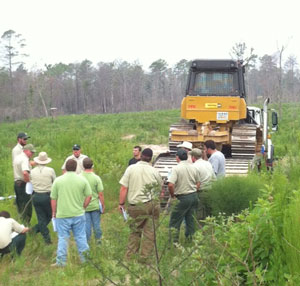By: Todd Thomas, Water Resources Forester, Texas Forest Service
 Q:
Q: Although it does not happen very often, occasionally I will come across a landowner who is not interested in leaving any sort of SMZs on their property. Next time I encounter this sort of situation, how should I handle it?
A: The best way to deal with this is to be informed of all of the benefits provided by SMZs. The first and foremost function of an SMZ is to protect water quality. SMZs protect water quality in four primary ways. The first is to slow down runoff from the surrounding area. By slowing down runoff, the potential for erosion next to the stream has been greatly reduced. The second is holding the soil adjacent to the stream in place; the roots of the vegetation that encompasses the SMZ do a tremendous job of this. The third is thermal protection. The shade provided by the SMZ helps to maintain the pH and the amount of oxygen in the water, maintaining the health of aquatic plants and animals. The fourth way that comes to mind is interception. SMZs intercept rainfall and drastically reduce the amount of sediment that can be displaced as a result of raindrops hitting bare soil directly. Remember, if we want clean water it only makes sense to protect it at its source.
If providing them with information on how SMZs protect water quality is not enough, provide them with some information on how SMZs benefit wildlife. It seems that most private landowners enjoy the wildlife on their property in some capacity and giving them this information could potentially change their mind. Any hunter knows that when you are in a clearcut, one of the best places to hunt is right along an SMZ, no matter what your quarry. One way that SMZs benefit wildlife is by providing edge. In a clearcut, edge is the area adjacent to the boundaries of the clearcut and the area around the SMZ. In these areas, the amount of vegetation that provide food for the wildlife is tremendous due to the amount of sunlight that previously was not reaching the area as well as an increased availability of nutrients and water. SMZs also provide travel corridors for wildlife. Since the SMZ is not as exposed as the rest of the clearcut, wildlife such as deer prefer to use it for travel due to less exposure. Many animals also use SMZs as nesting, den, and bedding sites; also a result of decreased exposure.
If they still are not convinced, remind them that according to Texas Forestry BMPs, SMZs can be thinned as long as they are not thinned so that the basal area gets below 50 square feet per acre. This allows a logger to remove the commercially viable timber while still maintaining the integrity of the SMZ. Basically, this land is not totally taken out of production, just managed in a fashion that protects water quality.
SMZs are an integral part of our best management practices and there is no good reason for removing them. Next time a landowner asks you to cut through an SMZ, remind them of all of the benefits provided by SMZs and what they will be missing out on. Remember, to send any questions you have about BMPs my way and I will be more than happy to answer them. You can reach me by e-mail at
tthomas@tfs.tamu.edu or by phone at 936-639-8180.
*This article was published in the June 2012 issue of the Texas Logger
 Recently-hired resource specialists got a chance to learn about water quality protection issues during a workshop in Hudson.
Recently-hired resource specialists got a chance to learn about water quality protection issues during a workshop in Hudson.




